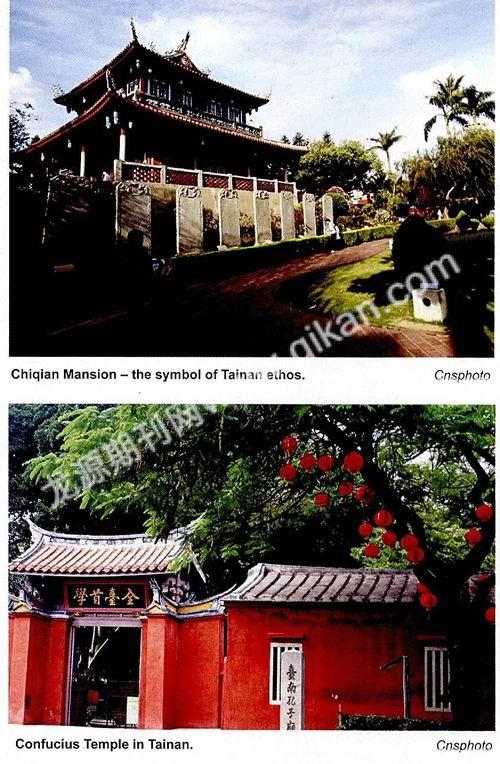The Customs and Folklore of Taiwan
YANG SI
WHAT we call Taiwan, and may think of – lazily – as a single island, is in fact an archipelago of over 80 isles. Her complexity is considerable, and it doesnt stop with geography. Pivoting around Taiwan Island, their 36,000 square kilometer mass is split by the Tropic of Cancer into two climates, the subtropical north and the tropical south.Socially, the region falls into 25 cities and counties. But Taiwans complexity ismore than climatic or administrative; cultural and historical events have shaped the nature of the place.

The original furnishings and décor have not survived the intervening 300 years, but the course of history can be read in remnants of the old outer city.
The island was a lure to foreigners and its terrain no deterrent to invaders or conquerors among them. The major body, Taiwan Island, has a swath of plain on the western shore providing horizontal relief from the remaining two thirds of the territory, shriveled by steep mountains and valleys. At the beginning of the 17th century, both the Dutch and Spanish invaded Taiwans shores, the Dutch finally routing the Spanish in 1642 to make the whole of Taiwan its colony.
In 1661 General Zheng Chenggong of the Southern Ming regime (1644-1662) moved to repossess it, leading his army of 25,000 soldiers and hundreds of ships in a 10 month siege against the colonists. The region was to be lost again 200 years later.After Chinas defeat in the 1894-1895 war with Japan, Taiwan was ceded to the victor as spoils. It was returned to China in 1945 at the close of World War II.
By the 1960s Taiwans economy had begun to heat up, and it soon won inclusion in Asias Four Little Dragons, together with South Korea, Singapore and Hong Kong. Today it is viewed as a land of milk and honey – affluent with sugar, salt, rice, fruit, forest and fish.A sanctuary of butterflies and corals in great variety, the island appeals to tourists seeking unspoiled natural beauty.Visitors whose curiosity is cultural and historical also find much to appreciate.
Historical Sites

Tainan is one of the oldest cities in Taiwan, the regions cultural, military and commercial center as far back as the 17th century. Naturally it had to have a castle at its heart. The Anping Castle was established by the Dutch in 1643 under the name Fort Zeelandia. This fortress had a square inner city serving as headquarters for Dutch occupiers, while the rectangular outer city lent itself to foreign traders. After Zheng Chenggong chased the Dutch off the island, he renamed the castle after his hometown in Fujian Province.
Today Tainan is the fourth largest city in Taiwan, and the Anping Castle has been transformed into a cultural museum. The original furnishings and décor have not survived the intervening 300 years, but the course of history can be read in remnants of the old outer city.Visitors are asked to consider the wall in the mottled shade of the snarled Chinese Banyans (Ficus microcarpa). The red bricks that composed the wall show two hues: a darker and a lighter. The darker ones were imported from Indonesia by the Dutch, and the lighter ones were Zheng Chenggongs shipment from Fujian.
Locals hold that Chiqian Mansion is the symbol of Tainan ethos. It is said to be the spot where the tide turned in favor of Zheng Chenggongs army in the battle against Dutch colonialists. Later the victorious Zheng selected the site as his center of operations. On the mansion grounds a sculpture commemorates Zheng receiving the capitulation letter from the occupiers, near a 300-year-old memorial temple built for the national hero. “Holy King who founded Taiwan,” as citizens dubbed him, is still highly revered by Taiwan people.Rites to honor him are held on April 29 and August 27 every year under the auspices of the local authority.As for the Chiqian Mansion likeness, there are more than 200 other such shrines to Zheng across Taiwan, plus 36 streets and institutes named after him, including a university.

A life-sized replica of a warship in Zhengs navy is a reconstruction project of historical and marine interest, currently the happy task of a Tainan City resident. In keeping with the originals, they are being constructed in Asian walnut, a wood native to the island.The time-travelling boats are scheduled to be displayed at the citys 8th Zheng Chenggong Cultural Festival next year.
Satisfying the Six Accomplishments Confucius believed essential to the making of decent and capable people needed both skills and knowledge – of etiquette, music, archery, driving (chariot), literature and mathematics. The Six Accomplishments Dance is performed annually at the oldest Confucius temple in Taiwan, built in the Yongli Period (1646-1662) in the Southern Ming regime.These Confucius rites are enacted with talent supplied by the Zhongyi Primary School next door.
After lunch everyday, a group of handpicked children from the sixth grade rehearse the movements that have been staged in Tainan for 300 years. Their tutor Wang Yingxiong, a teacher there for 30 years, continued this aspect of his work after retirement.Like a professional engagement or a religious ritual, the dance production is fraught with solemn anticipation. Before the day of the annual rite, the 36-student troop is sequestered in a hotel with their tutor. At 3 am the next day they rise together, put on the traditional robes, and file into the temple an hour later to begin the enchantment of their audience. For these young students of Confucius, their pride is made stronger and lessons more powerful by their special connections with the ancient sage – the transience of their dance within the enduring temple.

The Confusius temple was also the highest tertiary education institute in Taiwan during the Qing Dynasty. Still hanging over the gate of its compound is the plaque reading “supreme school of entire Taiwan.” It also proudly epitomizes southern Fujian traditional architecture. Three centuries of reconstruction and expansion to the edifice demonstrate its importance to the locals, to history and to the building arts.
The Dacheng (Great Achievements) Hall of the temple accommodates the memorial shrine and tablet dedicated to the great philosopher. On the beams above hang inscribed plaques from no less than eight Qing emperors. The one from Emperor Kangxi (1654-1722) reads, “Teacher of Ten Thousand Generations,” and that from Emperor Qianlong (1711-1799) says, “As Sacred as the Earth and Heaven.” In the halls of the eastern and western wings are memorial tablets for the 72 disciples of Confucius and other prominent figures of Confucianism.

